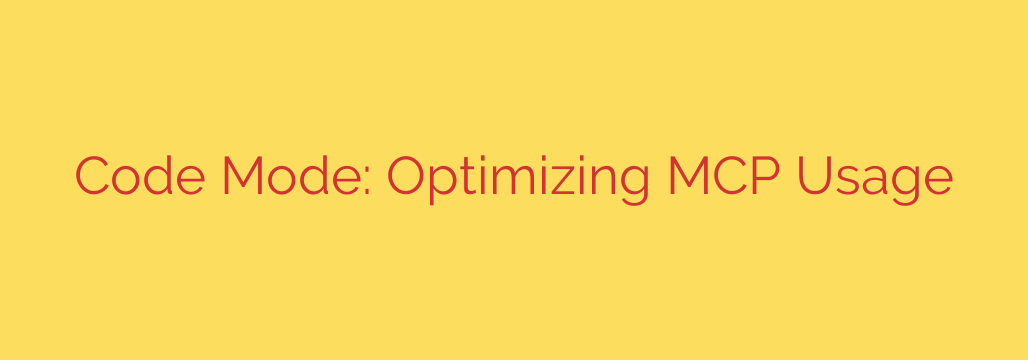
Unlocking Peak Performance: A Deep Dive into MCP Code Mode Optimization
In any complex system, achieving maximum efficiency often requires accessing its core functionalities. This is where high-privilege operational states, often referred to as a Master Control Program (MCP) Code Mode, come into play. While this mode offers unparalleled control and performance, its improper use can lead to system instability, security vulnerabilities, and performance bottlenecks.
Understanding how to leverage MCP Code Mode effectively is the key to building robust, secure, and high-performing applications. This guide explores the best practices for optimizing its usage, ensuring you harness its power without succumbing to its risks.
What is MCP Code Mode?
Think of MCP Code Mode as the system’s central nervous system—a privileged state that grants direct access to critical resources and hardware-level operations. Unlike standard operating modes that have built-in safeguards and abstractions, Code Mode allows for raw, unfiltered execution of commands.
This direct control is essential for tasks that demand the absolute lowest latency and highest throughput, such as real-time data processing, critical hardware management, or complex cryptographic operations. However, with great power comes great responsibility. Every operation executed in this mode has a significant impact on the entire system.
The Core Principle: Minimize Time and Scope
The most critical rule for using MCP Code Mode is to be surgical and efficient. The goal is not to run your entire application in this elevated state, but to use it for short, precise bursts of activity that are absolutely necessary.
The fundamental principle of optimization is to limit the duration and frequency of MCP Code Mode execution. Every clock cycle spent in this mode is a cycle where other processes may be stalled and system-wide security is at a higher risk.
Follow these key strategies:
- Isolate Critical Code: Before entering Code Mode, ensure your logic is stripped down to the bare essentials. Perform all data preparation, validation, and non-critical calculations in a standard, safer operating mode.
- Enter, Execute, Exit: Treat your time in Code Mode as a quick, targeted mission. The process should be to prepare data, enter the mode, execute the single critical function, and exit immediately. Lingering in this state is a primary cause of system instability.
- Avoid Complex Logic: Keep branching, loops, and complex conditional logic within Code Mode to an absolute minimum. These constructs increase execution time and introduce a higher probability of unforeseen errors in a high-stakes environment.
Security Hardening for a Privileged State
Given its power, MCP Code Mode is a prime target for malicious actors. Any vulnerability within code executed in this mode can have catastrophic consequences, potentially leading to a full system compromise. Therefore, security is not an afterthought—it’s a prerequisite.
Treat every entry into MCP Code Mode as a significant, auditable security event. Your implementation should be built on a foundation of zero-trust principles.
Here are essential security tips:
- Strict Access Control: Implement rigorous checks to control which parts of an application are authorized to request entry into Code Mode. Access should be granted on a least-privilege basis.
- Input Sanitization: Never trust data entering Code Mode. All input parameters must be rigorously validated and sanitized before the mode is activated. A malformed input could easily trigger a buffer overflow or other critical vulnerability.
- Comprehensive Auditing: Log every entry and exit from Code Mode, including what process triggered it and for how long it was active. This trail is invaluable for debugging performance issues and for forensic analysis after a security incident.
Common Pitfalls and How to Avoid Them
Many performance and stability issues can be traced back to a few common mistakes in handling MCP Code Mode. By being aware of these pitfalls, you can proactively design a more resilient system.
- Unnecessary State Transitions: Constantly entering and exiting Code Mode for trivial, fragmented tasks can create more overhead than it saves. It’s often better to batch small, related operations into a single, efficient execution block within the mode.
- Resource Contention: Code executed in this privileged state may lock critical system resources, starving other processes. Be mindful of any locks you create and ensure they are held for the shortest possible duration to prevent deadlocks and performance degradation.
- Neglecting Error Handling: An unhandled error within MCP Code Mode is rarely recoverable and often results in a system crash. Implement robust error-handling and fallback mechanisms to ensure the system can fail gracefully if an issue occurs during privileged execution.
By treating MCP Code Mode as the powerful and sensitive tool that it is, you can unlock significant performance gains while maintaining a secure and stable system. Focus on precision, efficiency, and security to build applications that are both fast and resilient.
Source: https://blog.cloudflare.com/code-mode/








